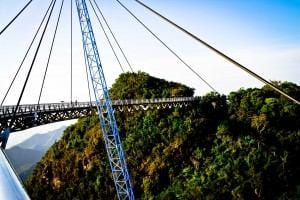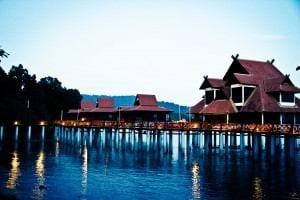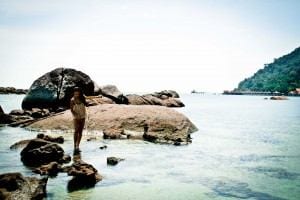Travel Tips
Maps, Not Google: Traveling by Instinct Through Malaysia
Many travelers dream of finding secret, untouristed beaches devoid of welcome drinks and tiki bars. Contributor Courtney Crockett relied on paper maps, night trains and instinct (OK, and a quick Internet cheat) to find her version of paradise in Malaysia.
I can’t remember the last time I planned anything based on a map. A good old-fashioned physical map that you can hold in your hands. The kind that is sure to point you in the right direction, sequentially. I can’t remember because it never happened.
I am reliant, for better or for worse, on blogs, reviews and word of mouth to plot my globetrotting. I credit my fearlessness of the world to hours of meticulous research that breathe a certainty of safety, and a checklist for all the “top” sites to see and “best” places to shop and eat. But travel is a gateway drug, and I found myself consumed by a craving for something more uninhibited and raw. Somewhere without welcome drinks and Wi-Fi. Somewhere, like Malaysia.
 The week prior to departure I fasted from Google, Afar, and the entire blogosphere. I didn’t book anything until the morning of my flight. Amidst a fog of anxiety, I scanned the first page of Vayama’s sweet deals and picked out a B&B in the Little India district of Singapore. Bypassing reviews and pictures of every accommodation option in my price range was killing me, but I had a flight to catch. I grabbed my backpack, passport and little sister, whom I manipulated into joining me under the notion that I knew every road, route and runway under the sun.
The week prior to departure I fasted from Google, Afar, and the entire blogosphere. I didn’t book anything until the morning of my flight. Amidst a fog of anxiety, I scanned the first page of Vayama’s sweet deals and picked out a B&B in the Little India district of Singapore. Bypassing reviews and pictures of every accommodation option in my price range was killing me, but I had a flight to catch. I grabbed my backpack, passport and little sister, whom I manipulated into joining me under the notion that I knew every road, route and runway under the sun.
Upon arrival, I collected a handful of city guides and studied them in private, careful not to become my biggest pet peeve; a naive tourist stopped with a map.
Enter night trains, which single-handedly shaped our journey. From Singapore we headed to Kuala Lampur, a city crucial to making moves within Malaysia. KL’s capital status and whispers of good shopping (exceptionally true) justified a couple nights’ stay. The 11:30 pm departure to KL is the third and final on the daily schedule. The train was air-conditioned and well kept, and our sleeper seats were a top bunk with clean and crisp white sheets. For $30, you can go to sleep in Singapore and wake up in KL around 7 am. One aspect of night trains I didn’t account for was showering…or lack there of. Like on many trains, washing up in the bathroom actually made me feel dirtier than when I went in. Colgate Whisps and cleansing wipes suddenly took precedence over water.
You can store your luggage at KL Sentral Station and hit the city immediately, which we did. It took every ounce of my strength to morph my backpack into the 2 x 2 foot box they called a locker. After accomplishing the impossible, I walked by the prayer rooms and lockers big enough to fit a sumo wrestler. The station is as central as it could possibly be, so you can easily come back for your things if checking into your hotel late, or leave them up to 24 hours.
Night train #2, with a different exchange rate, totaled only $16. I bought 15 minutes of Internet at the bookstore in KL Sentral. There were two major coastal destinations on the night train route up the Northwestern tip of Malaysia: Penang (via Butterworth) and Langkawi (via Arau.) We headed up this coast because of its proximity to Phuket, and my oh so logical assumption the landscape had to be “exactly the same.” After a week with long days, tired feet, and street food, I wanted 48 hours on a beach and a Mai Tai.
I caved, and enlisted in my long lost companion, Google. “Which has more beautiful beaches, Penang or Langkawi?” It was as if Trip Advisor was punishing me for cheating. Literally every response alternated destinations with passionate reasoning. Thanks for nothing. Eight minutes of Internet remaining. The ticket clerk informed us we would have to take a short ferry to reach Langkawi. I like ferries, so Langkawi it was.
I searched for a hotel and began booking a beachy bungalow for $75 a night. At the final stage of reservations, a note said you must be fully clothed around the pool to observe Islamic custom. After being respectfully covered all week and enduring the 95-degree heat and humidity, this simply was not going to happen. I was going to get a tan in a bikini if it meant hiring a local fisherman to drop me off on a deserted island. I kept searching until the last option, a proven winner by way of two words: Western beachwear. It was double the price, but saving an unexpected amount of money on night trains gave me a guilt-free pass to close the book on B&Bs, hostels and bungalows. It looked really nice, and they had a swim up bar… sold.
 We woke up in the jungle, literally. Branches of enormous palms and ferns swept across the windows. The fauna was so dense that visibility was only a few feet out. A couple hours of jungle led into the homestretch of rice paddies and sugarcane fields. We arrived in Arau, where it seemed everyone who departed the train was headed to Langkawi. “Everyone,” by the way, meant 100 percent locals, minus us. We made our way to the port, and embarked on a slow ferry ride that featured an incredibly corny Japanese kung-fu movie dubbed in Malay for the entire hour.
We woke up in the jungle, literally. Branches of enormous palms and ferns swept across the windows. The fauna was so dense that visibility was only a few feet out. A couple hours of jungle led into the homestretch of rice paddies and sugarcane fields. We arrived in Arau, where it seemed everyone who departed the train was headed to Langkawi. “Everyone,” by the way, meant 100 percent locals, minus us. We made our way to the port, and embarked on a slow ferry ride that featured an incredibly corny Japanese kung-fu movie dubbed in Malay for the entire hour.
Once on the island, we followed signs to the taxi stand, and hopped in for a negotiated rate of $13. Along the 45-minute route our driver gave us a tour and the full history of the island. At 29, he had a family of seven and ten siblings who all lived on Langkawi. I sensed this was the norm. He raved how his beloved “Anna and the King” was filmed on the island, and he met “the most beautiful angel” Diane Lane. He spoke about her like she was the descendant of both Mother Teresa and Adriana Lima.
We arrived at the Berjaya Resort. This was the moment I truly understood the value of the exchange rate. My love for welcome drinks was instantly revived.
Our “chalet” was a dark wood villa on stilts that backed up to the rainforest. A little buggy drives you around and is at your beck and call during your stay as every chalet is spread out. We were advised to keep our screens locked because monkeys often play on the decks and would love to come inside to souvenir shop in your suitcase. From that point on our gazes lifted to the treetops, monkey spotting never got old. Some would stare back from a high branch, and others from your front steps. Five-foot long monitor lizards and flying lemurs also made brief appearances during our stay.
 The beach exceeded my Phuket-like expectations. The Andaman Sea water is an exotic turquoise bath with floating strings of French Polynesian style villas. We walked the white sand beach for miles, crossing streams and rock beds, passing pint-size tiki bars, grazing water buffalo, colorful clusters of wooden fishing boats, and everything in between.
The beach exceeded my Phuket-like expectations. The Andaman Sea water is an exotic turquoise bath with floating strings of French Polynesian style villas. We walked the white sand beach for miles, crossing streams and rock beds, passing pint-size tiki bars, grazing water buffalo, colorful clusters of wooden fishing boats, and everything in between.
In 2008, Sultan Abdul Halim declared Langkawi as the official “jewel” of the Kedah state of Malaysia. Jewels, plural, would have been a better label, as there are 99 islands that make up the archipelago. Among the colorful clusters of wooden boats are captains willing and eager to show you the surrounding 98, take you out for a dive, or around to the other side of the main island to discover the bat caves and mangroves. If you have a whole day, they’ll even take you to the Belawan Port of Sumatra, Indonesia or upwards to the bordering Thai islands. The price is on par with any tourist boat, but Mother Nature’s soundtrack won’t be drowned out by a Hawaiian-shirted guide with bad jokes and a fuzzy microphone.
The “jewel” is dotted with street markets, elaborate mosques, golf courses, and hiking trails that end in waterfalls or hot lakes. My favorite dot on Langkawi had to be the Panorama cable car. Standing 700 meters above sea level in the Gunung Machincang range, you see a 360-degree view of the island, and all the “wooden boat” destinations in the distance. A walk on the suspension bridge around 6:30 pm serves up a breathtaking sunset that still sits in my top five.
Post-adventure Googling showed Langkawi, Malaysia earned a spot on some of the most trusted lists of “Top 10 Beaches of the World.” My reaction was bittersweet. I was disappointed; the off-season lack of tourists and remote vibe had me convinced I discovered an under published oasis. On the sweet side, I found the jewel, thanks only to circumstantial train routes, geographical instinct, and a big paper map.
For more on travel in Malaysia, check out:
- How to volunteer at Zoo Negara in Malaysia
- One journalist’s report on four decades of traveling through Malaysia
- Signature Dishes from Chef Raymond Tan at the Sunway Resort & Spa
By Courtney Crockett for PeterGreenberg.com












